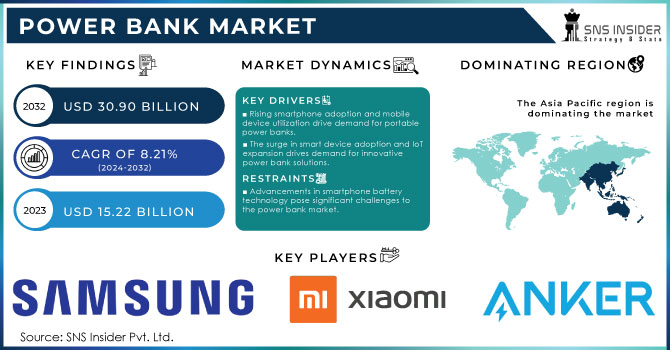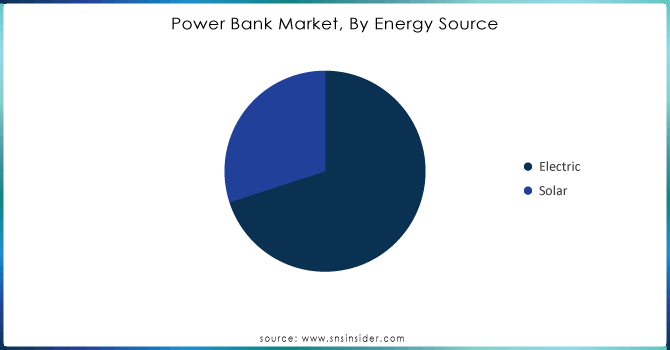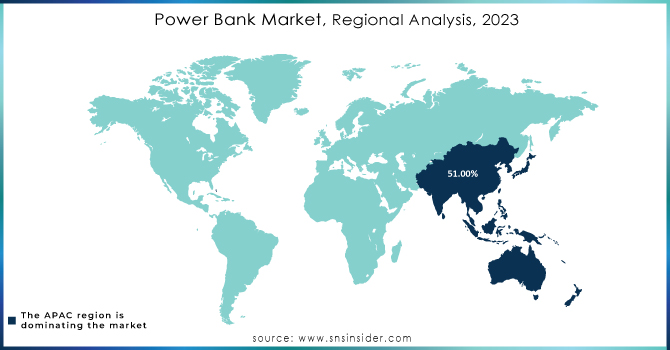Power Bank Market Size & Trends:
The Power Bank Market Size was valued at USD 15.22 Billion in 2023. It is estimated to reach USD 30.90 Billion by 2032, growing at a CAGR of 8.21% during 2024-2032.
The power bank market has seen significant growth over recent years, driven by the increasing reliance on portable electronic devices and the demand for uninterrupted power supply. One of the primary factors driving the growth of the power bank market is the surge in smartphone penetration globally. As smartphones become indispensable for personal and professional communication, internet access, and entertainment, the need for consistent and reliable power sources has grown.

Get More Information on Power Bank Market - Request Sample Report
The global smartphone market experienced a notable 10% year-on-year growth in Q1 2024, totaling 300 million units shipped. This resurgence marks the first double-digit growth after ten challenging quarters, driven by refreshed product portfolios and improved macroeconomic conditions in emerging markets. People are increasingly dependent on mobile devices throughout the day for various activities such as streaming, gaming, social media, and work-related tasks. The power demands of these activities often exceed the battery life of most devices, leading to a heightened demand for power banks as a convenient charging solution.
The introduction of 5G networks is forecasted to increase the power bank market even more. In early 2024, the global expansion of 5G technology is quickly gaining pace, with around 1.9 billion users recorded. It is expected that this number will almost double, reaching approximately 3.5 billion by 2025, showing a notable change in consumer preference towards this technology. Approximately, around 50% of the world's population can now connect to 5G networks, with this percentage predicted to increase to around 70% by 2026. By 2025, the market for 5G services is expected to surpass USD 100 billion in revenue, fueled by the growing need for fast internet and the increasing quantity of IoT devices. Due to the faster data speeds and improved connectivity facilitated by 5G technology, devices will probably use more power, increasing the necessity of portable chargers. The anticipated trend will increase the need for power banks with larger capacities that can facilitate quicker and more frequent recharging.
Power banks are more commonly incorporated into different outdoor and industrial environments. In the fields of construction, logistics, and emergency response, employees frequently work in areas with restricted availability of conventional electrical sockets. Verizon uses power banks to improve its remote telecommunications system, giving field technicians a portable and dependable power supply in areas without consistent electricity. These power banks allow technicians to supply power to telecommunications devices like routers, switches, and diagnostic tools so they can perform real-time testing, troubleshooting, and repairs. This method enhances operational efficiency by minimizing downtime and allowing maintenance and installation tasks to continue without interruption. Power banks provide a mobile way to ensure that communication devices, GPS systems, and important equipment remain operational. Moreover, power banks are commonly utilized by outdoor enthusiasts like hikers, campers, and travelers to ensure their devices stay charged in secluded areas.
Power Bank Market Dynamics
Drivers
-
Rising smartphone adoption and mobile device utilization drive demand for portable power banks.
The global smartphone adoption and presence of advanced & portable devices such as smartphones, tablets, laptops as well as wearables have been the primary driver for the power bank market. Smartphones have been around for about a decade now and like it or not, they play an integral part in the functioning of daily lives whether you use them to communicate with friends or family all over the world (for free), as your mobile office, entertainment console, even to pay groceries. With the increase in device utilization and the general need for connectedness between devices, there has been a demand for more consistent sources of power. Power banks also work well when you forget to charge your battery and it drains quickly after continued use.
Considering that smartphones, computer tablets, and other mobile devices have high-resolution displays, powerful processors and always-on networking features like 5G, Bluetooth, or GPS the appetite for battery is increasing today. Power bank provides a great convenience to consumers who tend to be on the move and cannot charge their devices using conventional methods (i.e. wall outlets); instead allowing them to recharge their devices at any time, in any place.
-
The surge in smart device adoption and IoT expansion drives demand for innovative power bank solutions.
The increasing adoption of smart devices and the expanding Internet of Things (IoT) landscape are some other important reasons that led to the growth of the power bank market. The rise of smartwatches, fitness trackers, wireless earbuds, and a host of other Internet of Things (IoTs) has planted them as staples in the consumer's daily routine. These devices generally feature slightly smaller batteries, resulting in more regular charging, and heightened demand for portable power solutions like power banks.
Consumers are on search for portable charging solutions as smart home devices and wearables grow more prevalent. This trend is further fueled by the rate of integration of IoT devices that are heartbeats for healthcare, retail, and industrial use cases. Power banks which are capable of charging multiple devices simultaneously or can charge your device wirelessly as well have gained significant popularity. The IoT landscape is growing at an astonishing pace; some predictions suggest that there will be trillions of connected devices worldwide, come 2025. This increase is directly connected to the demand of power banks that could serve as a solution to repeated recharging, especially while using these products in the open air or when mobile.
Restraints
-
Advancements in smartphone battery technology pose significant challenges to the power bank market.
Rapid global progress in battery technology of smartphones and other portable consumer electronics goods is a key factor restraining the power bank market. Device manufacturers will always be working on devices and batteries that use less electricity and last longer between charges. The onslaught of new features supported by adaptive battery modes, more optimized power management software, and energy-saving-oriented processors on modern smartphones have significantly siphoned the need to rely on external charging solutions in most scenarios. No need to carry power banks for short trips and daily use (when battery capacities grow larger, batteries will still last a long time), Although, this is a major challenge as the power bank market depends on the smartphone battery life cycle to a very large extent.
-
The emergence of wireless charging solutions threatens the demand for traditional power banks.
Wireless charging technology is increasingly being adapted which is a warning sign for the power bank market. Now that we have wireless charging stations in cafes, airports, and cars charging is also easier than ever so consumers no longer need to carry a power bank with them. Further freeing the traditional means of charging are advancements like long-range wireless charging and also surface-changing technology. As a result, consumers in areas with wireless charging infrastructure are less likely to buy power banks, thereby somewhat reducing the demand for these devices where charging solutions are more advanced.
Power Bank Market Segmentation Overview
By Capacity Range
The 8,001 mAh to 20,000 mAh segment held a major market share of 38% in 2023 and led the market, as it offers a good mix of capacity and portability. Power banks within this range provide sufficient power to recharge devices multiple times, making them perfect for customers who use power-hungry devices such as tablets, laptops, or smartphones while on the move. Frequent travelers and professionals are attracted to the compact size of these devices, as well as their capability to charge multiple devices at once. Anker's PowerCore line, featuring a capacity of 20,000 mAh, has become a popular option for charging smartphones and laptops.
The 3,001 mAh to 8,000 mAh category is accounted to register the fastest growth rate during 2024-2032 because it is budget-friendly and provides enough power for regular users. These power banks are light and easy to carry, fitting conveniently in a pocket or small bag, perfect for fast-charging smartphones and wearable gadgets. The rise in need for compact power sources, particularly among city dwellers and students, is fueling substantial growth in this sector. For instance, Aukey's small 5,000 mAh power bank is ideal for individuals who require a quick charge while traveling or doing errands.
By Energy Source
Electric power banks dominated the market with a 70% market share in 2023 because they are widely accessible and cost-effective. They are adaptable, compatible with a range of devices like smartphones, tablets, and laptops, and can be charged using regular electrical sockets. Continuous advancements in battery technology, which result in greater capacities and faster charging capabilities, have contributed to the boost in their popularity. Many customers favor electric power banks due to their convenience and dependability when offering numerous charges. Major players such as Anker and Xiaomi provide electric power banks with quick charging and multiple USB ports. These power banks are extremely convenient for everyday use, which is why they are the most popular segment in the market.
The solar power bank is expanding quickly and accounted to have a rapid CAGR during 2024-2032, as a result of the rising need for environmentally friendly options and alternative energy sources for remote locations. Solar power banks utilize solar energy, making them perfect for outdoor pursuits such as camping and hiking, where electricity availability is restricted. Due to increased environmental consciousness, EcoFlow and Solio are prioritizing improving the efficiency and portability of solar charging. These power banks are widely used in areas with abundant sunlight and are becoming increasingly popular as renewable energy options become more commonly accepted.

Need Any Customization Research On Power Bank Market - Inquiry Now
By Battery Type
Lithium ion power banks led the market segment with a 78% market share in 2023 because they have a greater energy density, last longer, and are more compact. Their capacity to hold larger amounts of energy in a compact design enables users to power multiple charges for devices such as smartphones, tablets, and laptops, leading to their extensive use. Anker and Xiaomi utilize lithium-ion technology in their power banks, offering dependable, quick-charging solutions. The durability of lithium-ion batteries, along with their minimal self-discharge, enhances their position as leaders in the market.
Lithium Polymer is the fastest-growing segment and is expected to have a rapid CAGR during 2024-2032 due to its adaptable design, lightweight characteristics, and improved safety measures. Lithium-polymer batteries, in contrast to lithium-ion, utilize a gel-like electrolyte which allows for increased flexibility and the ability to conform to various shapes and sizes, enabling the creation of ultra-thin and creative device designs. Zendure and RAVPower have incorporated lithium polymer batteries in their power banks to create stylish, compact designs. Li-Po power banks are favored for portable electronics due to their enhanced durability and reduced chance of leakage.
Power Bank Market Regional Analysis
The APAC region led the market with a 51% market share due to its large population and high smartphone usage rates. Nations such as China, India, and Japan play a significant role, as they have a high need for portable charging options thanks to the rising usage of smartphones and electronic devices. The area is also advantaged by the prominent existence of companies such as Xiaomi, Anker, and Sony, fulfilling needs from both local and global markets. Companies like Xiaomi, have broadened their range of power banks by adding features such as quick charging and large-capacity options to appeal to technology-savvy customers.
North America is to experience rapid growth during 2024-2032 with a CAGR of 8.77% because of the rising popularity of mobile devices and portable electronics. The demand for power banks has increased due to the tech-savvy consumer base and the rise of the work-from-home culture in the region. Major companies such as Mophie and Belkin have released high-tech power banks that include wireless charging capabilities and solar-powered features. Businesses are concentrating on cutting-edge, high-capacity power banks that cater to the demands of professionals and travelers in need of dependable backup power for laptops, smartphones, and tablets, fueling the rapid growth of the area.

Key Players in Power Bank Market
The key players in the Power Bank market are:
-
Anker (PowerCore 10000, PowerCore Slim 10000 PD)
-
Xiaomi (Mi Power Bank 3, Redmi Power Bank 20000mAh)
-
RAVPower (RAVPower PD Pioneer 20000mAh, RAVPower 15000mAh Solar Power Bank)
-
Samsung (Samsung Wireless Power Bank, Samsung 20000mAh Power Bank)
-
Sony (CP-V10A 10000mAh Power Bank, CP-S15 15000mAh Power Bank)
-
Belkin (BoostCharge Power Bank 10K, BoostCharge Power Bank 20K)
-
Zendure (Zendure SuperMini 10000mAh, Zendure A8PD 26800mAh)
-
Aukey (Aukey PB-Y13 10000mAh, Aukey PB-XD26 26800mAh)
-
Mophie (Powerstation Plus XL, Powerstation Wireless XL)
-
Baseus (Baseus Adaman Metal 20000mAh, Baseus Mini JA 30000mAh)
-
Romoss (Romoss Sense 8+ 30000mAh, Romoss SW20 Pro 20000mAh)
-
Ugreen (Ugreen 10000mAh PD Power Bank, Ugreen 20000mAh Quick Charge Power Bank)
-
Lenovo (Lenovo PA13000 13000mAh, Lenovo PB420 10000mAh)
-
Ambrane (Ambrane Stylo 20K 20000mAh, Ambrane 15000mAh Power Bank)
-
Intex (Intex IT-PB16K 16000mAh, Intex PB11K 11000mAh)
-
ZMI (ZMI PowerPack 10000mAh, ZMI Aura 20000mAh Power Bank)
-
Philips (Philips DLP1710CB 10000mAh, Philips DLP1716 16000mAh)
-
iMuto (iMuto 20000mAh Compact Power Bank, iMuto 30000mAh Ultra High Capacity)
-
Pisen (Pisen Power Cube 20000mAh, Pisen Wireless Power Bank 10000mAh)
-
TP-Link (TP-Link TL-PB10000 10000mAh, TP-Link TL-PB20000 20000mAh)
Recent Development
-
Xiaomi Powerbank 25000 212W (September 2024): This is a new launch that has come out with a transparent design, has a capacity of 14,000mAh, and offers high-speed charging. That provides up to three ports with a total output of 212W, so it can fast charge multiple devices simultaneously. Power Bank 15000mAh External Charger with Nine Layer Safety Protection.
-
Samsung PD Power Bank 20,000mAh & 10,000mAh (March 2024): New power banks from Samsung with capacities of 20,000mAh and 10,000mAh featuring fast charging up to 45W and 25W respectively. The 10,000mAh model also comes with built-in wireless charging functionality to wirelessly power all smartphones both of them& dash, and both have a durable design that uses approximately 30% recycled plastic this time around.
-
Infinix 10000mAh Powerbank (April 2024): Infinix released an affordable 10,000 mAh power bank with dual USB output fast charge. It works with both Android and iOS devices, and it is designed to be small so that you can take it on the go.
-
Realme 33W Dart Charge Power Bank (August 2024): This power bank provides up to 33W fast charging PD, a capacity of just 10,000mAh, and is suitable for most Realme smartphones. It is small to make the travel, portable car charger extremely powerful not skimping on fast charging capabilities (allows rapid charge speeds) for all compatible devices.
| Report Attributes | Details |
|---|---|
| Market Size in 2023 | USD 15.22 Billion |
| Market Size by 2032 | USD 30.90 Billion |
| CAGR | CAGR of 8.21% From 2024 to 2032 |
| Base Year | 2023 |
| Forecast Period | 2024-2032 |
| Historical Data | 2020-2022 |
| Report Scope & Coverage | Market Size, Segments Analysis, Competitive Landscape, Regional Analysis, DROC & SWOT Analysis, Forecast Outlook |
| Key Segments | • By Capacity Range (Up to 3,000 mAh, 3,001 mAh-8,000 mAh, 8,001 mAh-20,000 mAh, Above 20,000 mAh) • By Battery Type (Lithium polymer, Lithium ion) • By Energy Source (Electric, Solar) • By Distribution Channel (E-commerce, Brick & Mortar) |
| Regional Analysis/Coverage | North America (US, Canada, Mexico), Europe (Eastern Europe [Poland, Romania, Hungary, Turkey, Rest of Eastern Europe] Western Europe [Germany, France, UK, Italy, Spain, Netherlands, Switzerland, Austria, Rest of Western Europe]), Asia Pacific (China, India, Japan, South Korea, Vietnam, Singapore, Australia, Rest of Asia Pacific), Middle East & Africa (Middle East [UAE, Egypt, Saudi Arabia, Qatar, Rest of Middle East], Africa [Nigeria, South Africa, Rest of Africa], Latin America (Brazil, Argentina, Colombia, Rest of Latin America) |
| Company Profiles | Anker, Xiaomi, RAVPower, Samsung, Sony, Belkin, Zendure, Aukey, Mophie, Baseus, Romoss, Ugreen, Lenovo, Ambrane, Intex, ZMI, Philips, iMuto, Pisen, TP-Link |
| Key Drivers | • Rising smartphone adoption and mobile device utilization drive demand for portable power banks. • The surge in smart device adoption and IoT expansion drives demand for innovative power bank solutions. |
| RESTRAINTS | • Advancements in smartphone battery technology pose significant challenges to the power bank market. • The emergence of wireless charging solutions threatens the demand for traditional power banks. |

